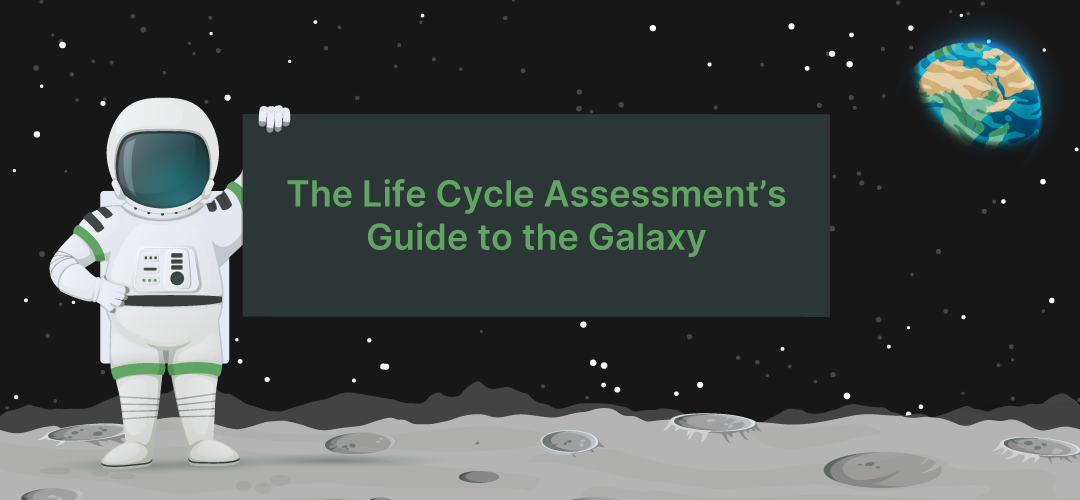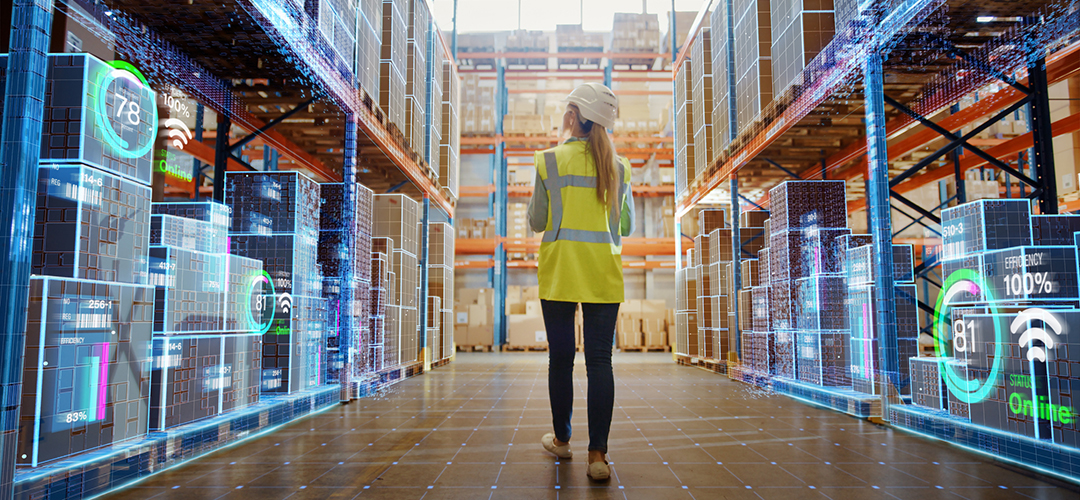Homage to the famous novel series by Douglas Adams, the Life Cycle Assessment’s Guide to the Galaxy delves into sustainability, efficiency, and innovation across the universe.
Welcome to the Galaxy of Sustainability

Imagine embarking on an interstellar journey, charting a course through the unknowns of sustainability, efficiency, and environmental impact. This is what Life Cycle Assessment (LCA) allows you to do in the vast landscape of business and product development.
Just like astronauts rely on the best navigational tools to explore outer space, businesses use LCA to assess the entire life cycle of a product — from raw materials to end-of-life disposal — to guide them toward more sustainable and impactful decisions.
In this Life Cycle Assessment’s Guide to the Galaxy, we will venture you into a journey through the most important concepts of LCA, guide you on how to navigate this essential process, and help you understand how it can transform your approach to sustainability.
[Chapter 1] Setting your coordinates: Understanding Life Cycle Assessment
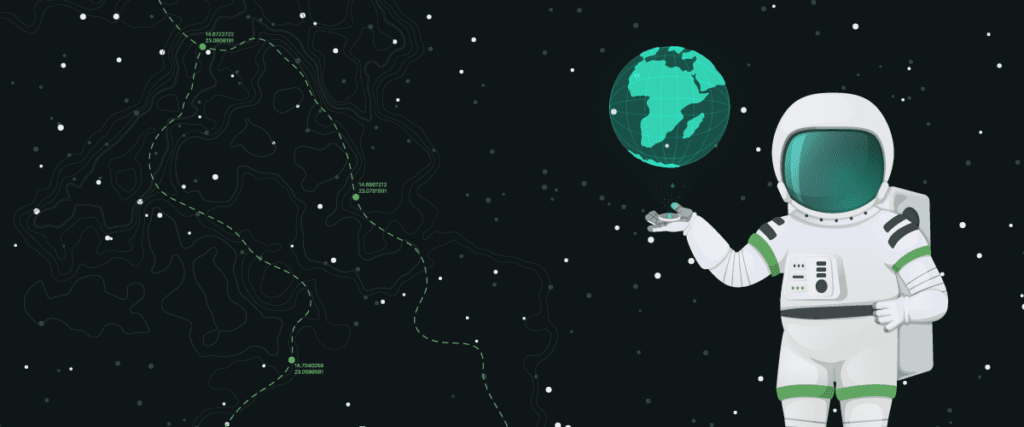
Before we begin our adventure, let’s define what Life Cycle Assessment is and why it is essential for the modern business landscape.
What is Life Cycle Assessment
Life Cycle Assessment is a systematic method used to evaluate the environmental impacts associated with all stages of a product’s life, from raw material extraction to production, transportation, use, and disposal.
The goal is to measure how a product impacts the environment — regardless if it is contributing to climate change, depleting resources, or polluting ecosystems. This approach provides data-driven insights into these effects, enabling businesses to make informed decisions.
Imagine LCA as your spaceship, guiding you through the complexities of environmental impacts and helping you reach a destination of sustainability.
What is the purpose of Life Cycle Assessment
The primary goal of Life Cycle Assessment is to understand the broader environmental impact of a product throughout its life cycle. By doing so, companies can:
- Reduce resource consumption
- Minimize environmental emissions
- Improve sustainability practices
- Optimize product design and efficiency
- Meet regulatory requirements
- Comply with the voluntary market
Through LCA, businesses can map their environmental footprint, identify areas for improvement, and make strategic decisions to reduce waste, emissions, and energy use.
[Chapter 2] Navigating the Galaxy: The four phases of LCA
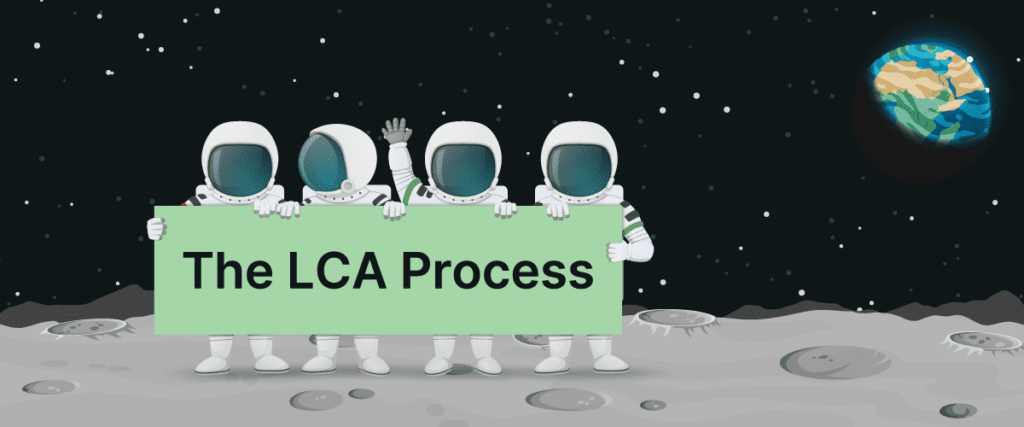
To successfully complete a Life Cycle Assessment, businesses must follow a structured methodology, divided into four key phases. Each of them plays an essential role in guiding the process, much like the stages of a space mission.
Goal and scope definition: Defining your trajectory
Before any journey, you need to know your mission’s objectives and the boundaries of your exploration, and running a Life Cycle Assessment is not different. The goal and scope definition phase defines the purpose of the study and determines what to include in the analysis.
- Goal definition: What do you want to achieve with your LCA? Are you seeking to reduce environmental impacts, assess eco-label certifications, or evaluate supply chain performance?
- Scope definition: What life cycle stages and environmental impacts will be included? Will you assess the full life cycle (cradle-to-grave), or will you focus on specific stages like production or end-of-life?
By clearly establishing the goals and scope, you ensure that your LCA aligns with business objectives and sustainability targets.
Life Cycle Inventory (LCI): Mapping the terrain
In this phase, you gather data on the resources, materials, and energy inputs, as well as the emissions and waste outputs throughout the product life cycle. Think of this as mapping your path and documenting your spaceship’s fuel consumption, materials usage, and waste produced.
- Data collection: The data collected in LCI includes energy consumption, raw materials, transportation distances, emissions (CO2, NOx, etc.), water use, and waste generation.
- Challenges in LCI: Gaps in data, uncertainty in supply chains, and varying methods of data collection can present challenges in this phase.
Despite these challenges, thorough and accurate data collection is crucial for understanding the environmental impact of each product phase.
Life Cycle Impact Assessment (LCIA): Evaluating the cosmic impact
The LCIA phase evaluates the significance of the environmental impacts identified during the LCI. This step is like analyzing the stardust collected on your journey — assessing how each piece affects the universe around it.
- Impact categories: Impact categories include global warming potential (carbon footprint), water depletion, ozone depletion, resource depletion, toxicity, and more.
- Methods of assessment: There are various methods for assessing these impacts, such as the CML, TRACI, and ReCiPe methods, which help translate raw data into meaningful impact measurements.
The LCIA phase enables you to understand how your product’s life cycle contributes to environmental challenges such as climate change, resource scarcity, and pollution.
Interpretation: Drawing conclusions from the stars
Once you have assessed the impact, it is time to interpret the results. What does the data tell you about your product’s environmental performance, and how can you improve it? This phase is like sending a message back to Earth — drawing conclusions that will guide future decisions.
- Actionable insights: The interpretation phase involves identifying hot spots — areas where the product has the most significant environmental impacts — and making recommendations for improvement.
- Strategic decision-making: This is where you can make decisions about redesigning products, switching to more sustainable materials, improving manufacturing processes, or adjusting transportation logistics to minimize emissions.
This phase is where the data truly begins to inform the future trajectory of your product’s sustainability journey. By identifying environmental impact areas and uncovering actionable insights, you can strategically guide your decisions toward more sustainable practices. The interpretation stage is crucial in turning knowledge into meaningful actions that propel your efforts toward a more environmentally responsible future.
[Chapter 3] Choosing the right gear: Software tools for the LCA mission

In any space exploration, having the right tools is critical to success. Similarly, Life Cycle Assessment requires specialized software to simplify data collection, analysis, and interpretation.
What is LCA software
LCA software is like a mission control center for evaluating the environmental impact of products and processes. Imagine it as the spacecraft navigating through the vast universe of environmental data, charting a course from the raw materials phase all the way to the final disposal.
In the same way that astronauts rely on precise instruments to monitor their journey, advanced technologies such as LCA software provide the tools to measure a product’s footprint, assessing its energy use, emissions, resource consumption, and waste production across its entire life cycle.
With its algorithms and databases, LCA software distills complex systems into actionable insights, much like how a space probe deciphers data from faraway planets, enabling companies to steer their product development toward a more sustainable orbit.
There are multiple advanced spacecraft available, each with its own unique capabilities for navigating the vast galaxy of environmental impact analysis, and P6 Technologies is considered the brightest star.
P6 Technologies
As the leading LCA software and only LCA enterprise platform in the Life Cycle Assessment universe, P6 Technologies is taken as one of the most powerful starships across the Galaxy. Equipped with custom functionalities and pre-built LCA templates for multiple industries, this is the only SaaS-based LCA software that will offer altogether:
- Industry-driven templates: Complete LCAs quicker with pre-built templates for Biogas, Transportation Fuels, and Renewable Chemicals.
- Comprehensive databases: Access biogas-specific life cycle inventory data to ensure accurate and reliable results.
- Regulatory compliance: Generate reports that align with global sustainability standards, including California LCFS, Washington CFS, Oregon CFP, Canada CFR, and Red II/III (ask us about others!).
- Scalability: Whether you are a small-scale producer or a large facility, the LCA software powered by P6 Technologies adapts to your needs.
- Exceptional support: P6 Technologies provides dedicated customer support and training to help users maximize the software’s potential.
LCA software tools help automate the LCA process, allowing for faster, more reliable results and more accurate environmental impact predictions.
[Chapter 4] Unlocking the treasure map: Why LCA is key to success
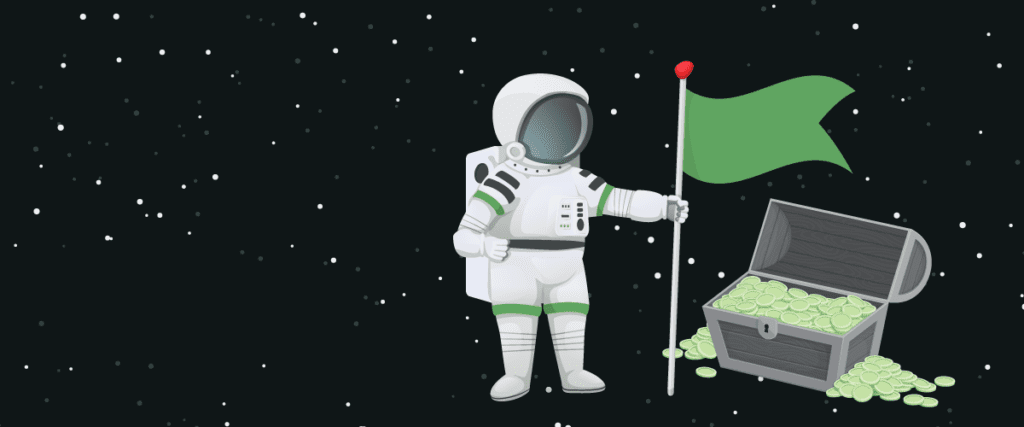
Now that you understand the basics of Life Cycle Assessment and the tools required for the mission, let’s explore why LCA is a fundamental part of your business’s sustainability journey.
Sustainable product design
Life Cycle Assessment helps businesses create products that are not only cost-effective but also environmentally friendly. By understanding the full impact of a product’s life cycle, businesses can design more sustainable products with minimal resource consumption and waste generation.
Improved decision-making
With Life Cycle Assessment, businesses can make more informed, data-driven decisions. Whether it’s choosing materials, improving manufacturing processes, or optimizing supply chains, LCA provides valuable insights that lead to better sustainability practices.
Compliance and certifications
Many businesses must comply with environmental regulations or seek eco-label certifications (e.g., Energy Star, Cradle to Cradle). Life Cycle Assessment can help companies meet these requirements and demonstrate their commitment to sustainability, building trust with customers and stakeholders.
Cost savings
While Life Cycle Assessment helps identify areas for environmental improvement, it also highlights opportunities for cost savings. By reducing energy consumption, minimizing waste, and optimizing supply chains, businesses can lower operational costs while achieving sustainability goals.
[Chapter 5] Going beyond the moon: The future of Life Cycle Assessment

Life Cycle Assessment is rapidly evolving, driven by new technologies, increased environmental awareness, and the growing demand for sustainability. Let’s look at the future of LCA and its expanding role in business strategy.
AI and automation
The integration of artificial intelligence and automation in LCA tools will make the process more efficient, allowing for real-time analysis and quicker insights. Businesses will be able to perform more dynamic, ongoing assessments of their products and supply chains.
Integration with business operations
In the future, Life Cycle Assessment will be more deeply integrated with other business operations, such as product design, marketing, and supply chain management. This will allow businesses to continuously monitor and optimize their environmental performance across the entire product lifecycle.
Circular economy
Life Cycle Assessment is a critical tool in the shift toward a circular economy, where resources are reused, products are designed for longevity, and waste is minimized. As businesses move towards circular models, LCA will help track and improve resource efficiency and reduce the environmental impacts of production.
Ready to take off on your LCA mission?

Congratulations! You have successfully completed your journey through the world of Life Cycle Assessment. By understanding the fundamentals of LCA, the phases of the process, and the benefits it provides, you are now ready to embark on your own sustainability mission.
The Galaxy of Sustainability is vast, but with the right tools and approach, you can navigate it with confidence. Remember, sustainability is an ongoing journey, and Life Cycle Assessment will be your trusty guide as you make decisions that not only benefit your business but also contribute to a greener, more sustainable planet.
The universe of possibilities is within reach! Start your mission today by exploring the interstellar LCA software powered by P6 Technologies to blast off your sustainability journey to new heights.
